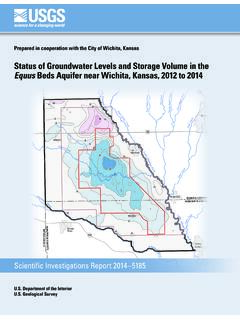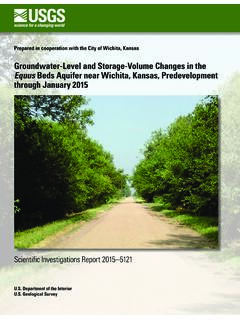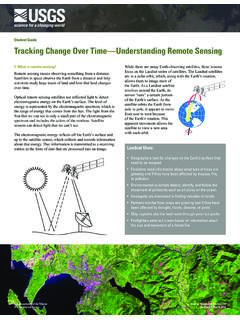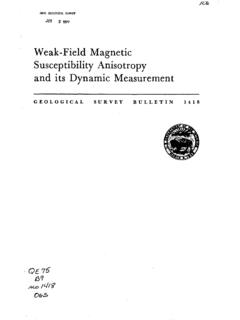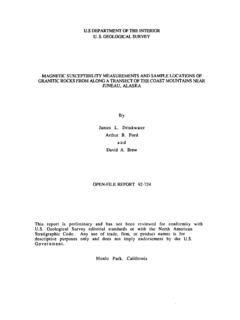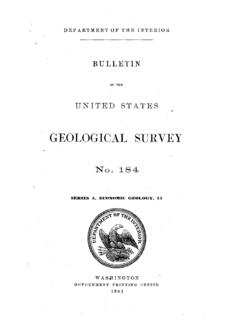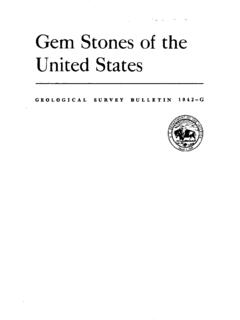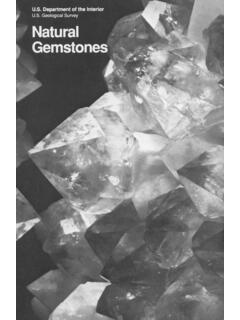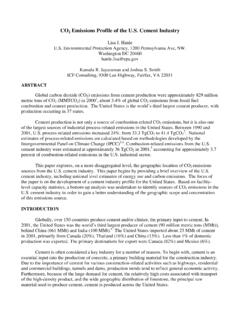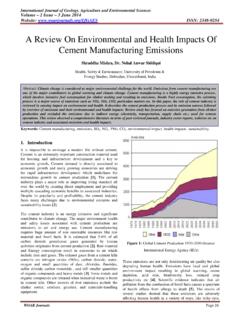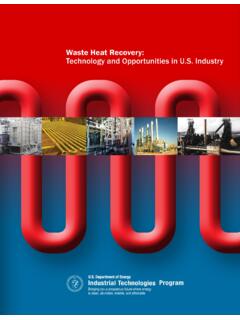Transcription of Cement - USGS
1 Cement . (Data in thousand metric tons unless otherwise noted). Domestic Production and Use: In 2020, portland Cement production increased slightly to an estimated 87 million tons, and masonry Cement production decreased slightly to million tons. Cement was produced at 96 plants in 34 States, and at 2 plants in Puerto Rico. Texas, Missouri, California, and Florida were, in descending order of production, the four leading Cement -producing States and accounted for nearly 45% of production. Overall, the Cement industry 's growth continued to be constrained by closed or idle plants, underutilized capacity at others, production disruptions from plant upgrades, and relatively inexpensive imports.
2 In 2020, shipments of Cement were essentially unchanged from those of 2019 and were valued at $ billion. In 2020, it was estimated that 70% to 75% of sales were to ready-mixed concrete producers, 10% to concrete product manufactures, 8% to 10% to contractors, and 5% to 12% to other customer types. Salient Statistics United States:1 2016 2017 2018 2019 2020e Production: Portland and masonry cement2 84,695 86,356 86,368 e88,000 89,000. Clinker 75,633 76,678 77,112 79,000 79,000. Shipments to final customers, includes exports 95,397 97,935 99,419 103,000 103,000.
3 Imports for consumption: Hydraulic Cement 11,742 12,288 13,764 14,690 15,000. Clinker 1,496 1,209 967 1,160 1,400. Exports of hydraulic Cement and clinker 1,097 1,035 919 1,002 1,000. Consumption, apparent3 95,150 97,160 98,500 e103,000 102,000. Price, average mill value, dollars per ton 111 117 121 e123 124. Stocks, Cement , yearend 7,420 7,870 8,580 e7,140 7,800. Employment, mine and mill, numbere 12,700 12,500 12,300 12,500 12,500. Net import reliance4 as a percentage of apparent consumption 13 13 14 14 15.
4 Recycling: Cement is not recycled, but significant quantities of concrete are recycled for use as a construction aggregate. Cement kilns can use waste fuels, recycled Cement kiln dust, and recycled raw materials such as slags and fly ash. Various secondary materials can be incorporated as supplementary cementitious materials (SCMs) in blended cements and in the Cement paste in concrete. Import Sources (2016 19):5 Canada, 33%; Turkey, 16%; Greece, 15%; China, 12%; and other, 24%. Tariff: Item Number Normal Trade Relations 12 31 20.
5 Cement clinker Free. White portland Cement Free. Other portland Cement Free. Aluminous Cement Free. Other hydraulic Cement Free. Depletion Allowance: Not applicable. Certain raw materials for Cement production have depletion allowances. Government Stockpile: None. Events, Trends, and Issues: In 2020, production of Cement was temporarily idled in many countries and localities in response to national lockdowns imposed to limit the spread of the global COVID-19 pandemic. The duration of the lockdowns and the return to full production following the restart of operations, varied by geographic region.
6 Disruptions to construction activities corresponded with reduced Cement demand, and some regions experienced increased fuel and freight costs. Additionally, several planned Cement plant openings and expansions were delayed. Prepared by Ashley K. Hatfield [(703) 648 7751, Cement . Despite the economic disruptions owing to the COVID-19 pandemic, the value of total construction put in place in the United States increased by about 4% during the first 9 months of 2020 compared with that of the same period in 2019.]
7 Residential construction spending increased more than nonresidential construction spending. A Cement plant in New York was idled in April because of decreased demand resulting from restrictions put in place to mitigate the spread of the virus. However, the Cement industry has shown no prolonged or widespread negative effects from the pandemic. The leading Cement -consuming States continued to be Texas, California, and Florida, in descending order by tonnage. Company merger-and-acquisition activity continued in 2020, with the completion of the sale of a Cement company in Kentucky.
8 In 2019, one European Cement company entered into an agreement to purchase a Mexican Cement company's plant in Pennsylvania and the transaction was still pending regulatory approval in 2020. Cement plant upgrades were announced at Cement plants in Alabama and Texas. Several minor upgrades were ongoing at some other domestic plants, and upgrades were also announced for a few Cement terminals. However, one Cement company delayed work on an upgrade to one of its plants in Indiana. Another company secured its final air permit for a new Cement plant in Georgia.
9 Numerous companies made announcements aligned with the industry 's commitment to sustainability, such as new product lines, renewable energy plans, decarbonization research initiatives, and other innovations. Many plants have installed emissions-reduction equipment to comply with the 2010. National Emissions Standards for Hazardous Air Pollutants (NESHAP). It remains possible that some kilns could be shut, idled, or used in a reduced capacity to comply with NESHAP, which would constrain clinker capacity. World Production and Capacity: Cement productione Clinker capacitye 2019 2020 2019 2020.
10 United States (includes Puerto Rico) 89,000 90,000 103,000 103,000. Brazil 54,000 57,000 60,000 60,000. China 2,300,000 2,200,000 1,970,000 1,970,000. Egypt 47,000 50,000 48,000 48,000. India 340,000 340,000 280,000 280,000. Indonesia 70,000 73,000 78,000 78,000. Iran 60,000 60,000 81,000 81,000. Japan 53,000 53,000 53,000 53,000. Korea, Republic of 50,000 50,000 50,000 50,000. Russia 56,000 56,000 80,000 80,000. Turkey 57,000 66,000 92,000 92,000. Vietnam 97,000 96,000 90,000 90,000. Other countries (rounded) 880,000 890,000 720,000 720,000.
